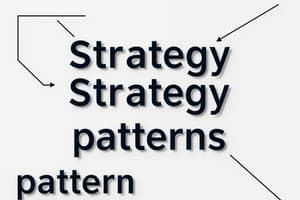Podcast
Questions and Answers
What is the primary advantage of using the Builder pattern in object construction?
What is the primary advantage of using the Builder pattern in object construction?
- It enables the creation of objects with different representations without changing the client code. (correct)
- It allows for the creation of objects without specifying the concrete classes of the objects.
- It eliminates the need for a separate builder class for each type of object.
- It forces the client code to call all the construction steps in a specific order.
Which of the following is a characteristic of the Builder pattern?
Which of the following is a characteristic of the Builder pattern?
- It separates the construction of an object from its representation. (correct)
- It requires the client code to specify the concrete class of the object to be created.
- It always builds the entire object in a single step.
- It uses a single, monolithic constructor to create objects.
What is the purpose of having multiple builder classes in the Builder pattern?
What is the purpose of having multiple builder classes in the Builder pattern?
- To increase the performance of the object construction process.
- To reduce the complexity of the client code.
- To provide multiple ways of creating the same object.
- To allow for the creation of different objects with the same set of construction steps. (correct)
Which of the following patterns is most similar to the Builder pattern in terms of object construction?
Which of the following patterns is most similar to the Builder pattern in terms of object construction?
What is the main difference between the Builder pattern and the Factory Method pattern?
What is the main difference between the Builder pattern and the Factory Method pattern?
What is the benefit of using the Builder pattern in terms of code reuse?
What is the benefit of using the Builder pattern in terms of code reuse?
What is the primary benefit of using the Factory Method pattern in terms of coupling?
What is the primary benefit of using the Factory Method pattern in terms of coupling?
In which scenario is the Factory Method pattern most suitable?
In which scenario is the Factory Method pattern most suitable?
What is the primary difference between the Factory Method pattern and the Abstract Factory pattern?
What is the primary difference between the Factory Method pattern and the Abstract Factory pattern?
What is the advantage of introducing the Factory Method pattern into an existing hierarchy of creator classes?
What is the advantage of introducing the Factory Method pattern into an existing hierarchy of creator classes?
Which pattern is often used to compose the methods on Abstract Factory classes?
Which pattern is often used to compose the methods on Abstract Factory classes?
What is the primary disadvantage of using the Factory Method pattern?
What is the primary disadvantage of using the Factory Method pattern?
Which principle does the Factory Method pattern support?
Which principle does the Factory Method pattern support?
What is the typical evolution of designs using the Factory Method pattern?
What is the typical evolution of designs using the Factory Method pattern?
Which of the following design patterns is used to construct complex objects step by step?
Which of the following design patterns is used to construct complex objects step by step?
Which design pattern is often used as an alternative to Facade when you only want to hide the way the subsystem objects are created from the client code?
Which design pattern is often used as an alternative to Facade when you only want to hide the way the subsystem objects are created from the client code?
Which design pattern specializes in creating families of related objects?
Which design pattern specializes in creating families of related objects?
Which design pattern is used to produce different types and representations of an object using the same construction code?
Which design pattern is used to produce different types and representations of an object using the same construction code?
Which design pattern is often implemented as a Singleton?
Which design pattern is often implemented as a Singleton?
Which design pattern uses a set of Factory Methods to create objects?
Which design pattern uses a set of Factory Methods to create objects?
Which design pattern is used to encapsulate the relations between abstractions and implementations?
Which design pattern is used to encapsulate the relations between abstractions and implementations?
Which design pattern is used to compose the methods on a class using Prototype?
Which design pattern is used to compose the methods on a class using Prototype?
What is the main issue that arises when trying to add a new class to the program if the rest of the code is already coupled to existing classes?
What is the main issue that arises when trying to add a new class to the program if the rest of the code is already coupled to existing classes?
What is the primary purpose of the Factory Method pattern?
What is the primary purpose of the Factory Method pattern?
What is a limitation of the Factory Method pattern?
What is a limitation of the Factory Method pattern?
What is the result of not using the Factory Method pattern when adding a new class to the program?
What is the result of not using the Factory Method pattern when adding a new class to the program?
What is the key difference between the Factory Method pattern and the Abstract Factory pattern?
What is the key difference between the Factory Method pattern and the Abstract Factory pattern?
When is the Factory Method pattern most suitable?
When is the Factory Method pattern most suitable?
What is the primary advantage of using the Factory Method pattern in terms of coupling?
What is the primary advantage of using the Factory Method pattern in terms of coupling?
What is the relationship between the Factory Method pattern and the Builder pattern?
What is the relationship between the Factory Method pattern and the Builder pattern?
What is the primary responsibility of the creator class in the Factory Method pattern?
What is the primary responsibility of the creator class in the Factory Method pattern?
How does the client code treat the products returned by the factory method in the Factory Method pattern?
How does the client code treat the products returned by the factory method in the Factory Method pattern?
What is the purpose of declaring a factory method in the base Dialog class in the cross-platform dialog example?
What is the purpose of declaring a factory method in the base Dialog class in the cross-platform dialog example?
What is the benefit of using the Factory Method pattern in terms of code reuse?
What is the benefit of using the Factory Method pattern in terms of code reuse?
What is the difference between the Factory Method pattern and the Abstract Factory pattern?
What is the difference between the Factory Method pattern and the Abstract Factory pattern?
What is the role of the product interface in the Factory Method pattern?
What is the role of the product interface in the Factory Method pattern?
What is the purpose of the factory method in the RoadLogistics class?
What is the purpose of the factory method in the RoadLogistics class?
What is the advantage of using the Factory Method pattern in terms of coupling?
What is the advantage of using the Factory Method pattern in terms of coupling?
What is the primary difference between the Factory Method pattern and the Builder pattern?
What is the primary difference between the Factory Method pattern and the Builder pattern?
What is the purpose of the factory method in the WindowsDialog class?
What is the purpose of the factory method in the WindowsDialog class?
Flashcards are hidden until you start studying
Study Notes
Relations with Other Patterns
- Many designs start with Factory Method, which is less complicated and more customizable via subclasses, and evolve towards Abstract Factory, Prototype, or Builder, which are more flexible but more complicated.
- Abstract Factory classes are often based on a set of Factory Methods, but you can also use Prototype to compose the methods on these classes.
Abstract Factory
- Abstract Factory specializes in creating families of related objects.
- It returns the product immediately.
- It can serve as an alternative to Facade when you only want to hide the way the subsystem objects are created from the client code.
- It can be used along with Bridge to encapsulate relations and hide complexity from the client code.
- Abstract Factory classes can be implemented as Singletons.
Builder
- Builder is a creational design pattern that lets you construct complex objects step by step.
- It allows you to produce different types and representations of an object using the same construction code.
- It organizes object construction into a set of steps (e.g. buildWalls, buildDoor, etc.).
- You can create different builder classes that implement the same set of building steps, but in a different manner.
- Different builders execute the same task in various ways.
- Builder can be implemented as a Singleton.
Problem
- Imagine a complex object that requires laborious, step-by-step initialization of many fields and nested objects.
- The initialization code is usually buried inside a monstrous constructor with lots of parameters or scattered all over the client code.
Pros and Cons of Factory Method
- Pros: avoids tight coupling between the creator and the concrete products, follows the Single Responsibility Principle, and follows the Open/Closed Principle.
- Cons: the code may become more complicated since you need to introduce a lot of new subclasses to implement the pattern.
Factory Method Pattern
- Also known as Virtual Constructor
- Solved problem: Code coupled to specific classes, making it hard to add new classes without changing entire codebase
Problem Scenario
- Logistics management application initially handles transportation by trucks, but needs to be extended to sea transportation
- Adding new classes (e.g., Ships) is complex due to tight coupling with existing classes
Solution
- Replace direct object construction calls with calls to a special factory method
- Factory method returns objects, often referred to as products
- Subclasses can alter the class of objects being returned by the factory method
Key Points
- The factory method in the base class should have its return type declared as an interface
- All products must follow the same interface
- Subclasses can return different types of products only if these products have a common base class or interface
- The client code treats all products as abstract, without knowing the actual product type
Example: Cross-Platform UI Elements
- Creating UI elements without coupling client code to concrete UI classes
- Factory method produces buttons inside the base Dialog class
- Subclasses can return Windows-styled or Linux-styled buttons from the factory method
Pseudocode Example
- Dialog class uses different UI elements to render its window
- Factory method produces buttons, which can be overridden in subclasses
- Client code works with an instance of a concrete creator, via the base interface
Studying That Suits You
Use AI to generate personalized quizzes and flashcards to suit your learning preferences.




